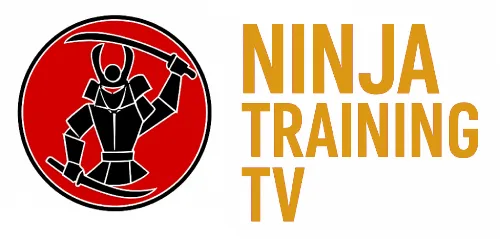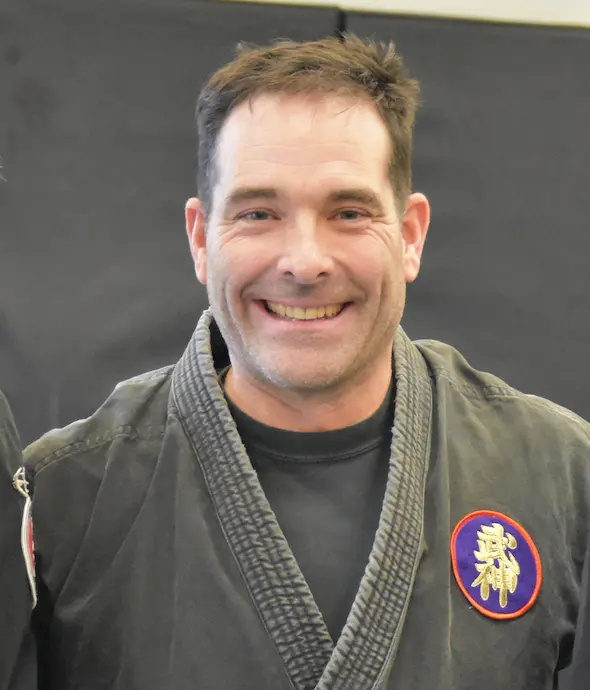If you’ve earned your Shodan (1st degree black belt), you already know: each rank in the Bujinkan isn’t just about learning more techniques, it’s about deepening your connection to the art. At Ninja Training TV, we’re excited to share that our brand new Nidan video series is now available. And it begins by taking you directly into the heart of the classical schools like Kukishinden Ryū and Gyokko Ryū with new material that challenges your taijutsu from the inside out.
Technique Spotlight: Uchi Waza (Kukishinden Ryū Hanbōjutsu)
In this clip, Sensei Mark Roemke demonstrates a classical hanbō technique from Kukishinden Ryū called Uchi Waza. The technique begins from Kata Yaburi no Kamae, with the attacker using a wakizashi to deliver a forward thrust.
This technique includes:
- Off-angle evasion (45° stepping)
- Precision strike to the attacking limb (preferably hand, not sword)
- Grip switching mid-flow
- Final thrust (tsuki) targeting the throat or face
These movements appear simple, but they require timing, targeting, and control. As always with the Ryū, the real power is in the nuance.
What Kukishinden and Gyokko Teach Us at Nidan
At the Nidan level, the Bujinkan path becomes less about collecting techniques and more about refining perception. This is where you begin to see the threads that connect schools, weapons, strategy, and mindset, and start weaving them into your own taijutsu.
Two cornerstone schools featured in the Nidan curriculum are Kukishinden Ryū and Gyokko Ryū, and each offers a distinct flavor of movement and battlefield logic. In the first video of the series, you can explore some of these concepts:
🔴 Kukishinden Ryū (九鬼神伝流) — “School of the Nine Demon Gods”
Known for its powerful and adaptable weapon work, Kukishinden brings a commanding presence to taijutsu. At Nidan, your training includes:
- Hanbōjutsu Shoden no Kata — Foundational short staff techniques like Katate Uchi and Uchi Waza, emphasizing grip switching, leverage, and aggressive positioning.
- Rokushakubōjutsu – Goho — A series of six-foot staff methods that teach you how to create structure through the hips and spine while maintaining fluid adaptability.
- Bikenjutsu (sword work) such as Tsuke Komi — Exploring timing, pressure, and closing distance, especially when blade meets blade or armor.
What makes Kukishinden so unique is its ability to translate principles across weapons. The same power you express through a hanbō strike can emerge through a sword cut or a bō sweep once you understand the internal structure behind it.
🟡 Gyokko Ryū (玉虎流) — “Jewel Tiger School”
If Kukishinden teaches how to dominate the battlefield, Gyokko teaches how to survive and outlast it.
From the Jo Ryaku no Maki (Upper-Level Strategy Scroll), you’ll train:
- Koku – learning to strike through “empty space” with precision, not force.
- Renyo – blending with the attacker and redirecting them like a spinning wheel.
From the Chu Ryaku no Maki (Middle-Level Strategy Scroll), you’ll explore:
- Da Shin – harnessing shock and instability to disrupt.
- Hanetsurube – a dynamic balance of rising and falling like a water bucket on a rope, teaching control through connection, not tension.
Gyokko Ryū demands subtle body manipulation of your own structure and the attacker’s. These kata are deceptively simple, but contain the DNA of almost every other movement in the Bujinkan, especially the Kihon Happō.
🧭 Where the Schools Meet
The Nidan level reveals that the “schools” are connected by strategy and principle:
- Kukishinden teaches you to own space and weapon flow.
- Gyokko teaches you to dissolve into timing and precision.
- Together, they ask you to move with confidence and humility, knowing when to control and when to release.
In this way, Nidan is about looking inward, refining what you’ve already touched, and learning to express it through the lens of the ryū.
More Than Just Watching
Watching a technique like Uchi Waza in video is a start. But once you pick up the hanbō and start to feel the transitions, timing, and target zones for yourself, the deeper lessons of the Ryū begin to reveal themselves. It’s not about perfecting a kata. It’s about feeling what the scrolls were trying to teach, and adapting them to your unique taijutsu and environment.
🥷 Ready for the Next Step?
Whether you’re just entering your black belt journey or you’re a seasoned student of the art, the Nidan series offers a bridge to deeper Bujinkan understanding.
We’re honored to keep these teachings alive, and we invite you to explore them with us… one step, one hanbō strike, one school at a time.

